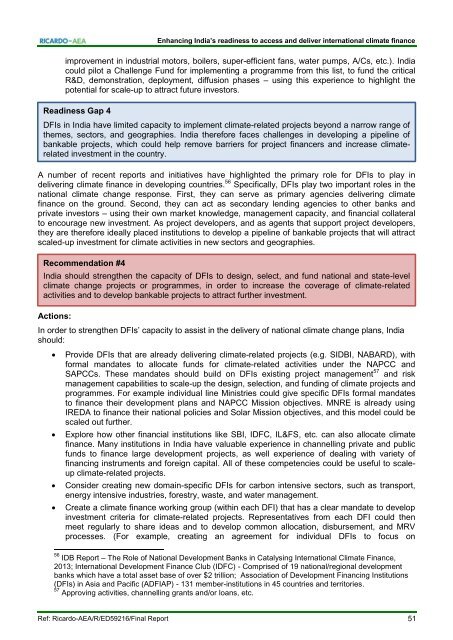Enhancing India’s Readiness to Climate Finance
India has taken several steps to improve its national response to climate change. India’s climate finance requirements, however, are very high, and will need to be met through a combination of public, private and international climate finance. See more at: http://shaktifoundation.in/
India has taken several steps to improve its national response to climate change. India’s climate finance requirements, however, are very high, and will need to be met through a combination of public, private and international climate finance. See more at: http://shaktifoundation.in/
- No tags were found...
Create successful ePaper yourself
Turn your PDF publications into a flip-book with our unique Google optimized e-Paper software.
<strong>Enhancing</strong> <strong>India’s</strong> readiness <strong>to</strong> access and deliver international climate finance<br />
improvement in industrial mo<strong>to</strong>rs, boilers, super-efficient fans, water pumps, A/Cs, etc.). India<br />
could pilot a Challenge Fund for implementing a programme from this list, <strong>to</strong> fund the critical<br />
R&D, demonstration, deployment, diffusion phases – using this experience <strong>to</strong> highlight the<br />
potential for scale-up <strong>to</strong> attract future inves<strong>to</strong>rs.<br />
<strong>Readiness</strong> Gap 4<br />
DFIs in India have limited capacity <strong>to</strong> implement climate-related projects beyond a narrow range of<br />
themes, sec<strong>to</strong>rs, and geographies. India therefore faces challenges in developing a pipeline of<br />
bankable projects, which could help remove barriers for project financers and increase climaterelated<br />
investment in the country.<br />
A number of recent reports and initiatives have highlighted the primary role for DFIs <strong>to</strong> play in<br />
delivering climate finance in developing countries. 56 Specifically, DFIs play two important roles in the<br />
national climate change response. First, they can serve as primary agencies delivering climate<br />
finance on the ground. Second, they can act as secondary lending agencies <strong>to</strong> other banks and<br />
private inves<strong>to</strong>rs – using their own market knowledge, management capacity, and financial collateral<br />
<strong>to</strong> encourage new investment. As project developers, and as agents that support project developers,<br />
they are therefore ideally placed institutions <strong>to</strong> develop a pipeline of bankable projects that will attract<br />
scaled-up investment for climate activities in new sec<strong>to</strong>rs and geographies.<br />
Recommendation #4<br />
India should strengthen the capacity of DFIs <strong>to</strong> design, select, and fund national and state-level<br />
climate change projects or programmes, in order <strong>to</strong> increase the coverage of climate-related<br />
activities and <strong>to</strong> develop bankable projects <strong>to</strong> attract further investment.<br />
Actions:<br />
In order <strong>to</strong> strengthen DFIs’ capacity <strong>to</strong> assist in the delivery of national climate change plans, India<br />
should:<br />
<br />
<br />
<br />
<br />
Provide DFIs that are already delivering climate-related projects (e.g. SIDBI, NABARD), with<br />
formal mandates <strong>to</strong> allocate funds for climate-related activities under the NAPCC and<br />
SAPCCs. These mandates should build on DFIs existing project management 57 and risk<br />
management capabilities <strong>to</strong> scale-up the design, selection, and funding of climate projects and<br />
programmes. For example individual line Ministries could give specific DFIs formal mandates<br />
<strong>to</strong> finance their development plans and NAPCC Mission objectives. MNRE is already using<br />
IREDA <strong>to</strong> finance their national policies and Solar Mission objectives, and this model could be<br />
scaled out further.<br />
Explore how other financial institutions like SBI, IDFC, IL&FS, etc. can also allocate climate<br />
finance. Many institutions in India have valuable experience in channelling private and public<br />
funds <strong>to</strong> finance large development projects, as well experience of dealing with variety of<br />
financing instruments and foreign capital. All of these competencies could be useful <strong>to</strong> scaleup<br />
climate-related projects.<br />
Consider creating new domain-specific DFIs for carbon intensive sec<strong>to</strong>rs, such as transport,<br />
energy intensive industries, forestry, waste, and water management.<br />
Create a climate finance working group (within each DFI) that has a clear mandate <strong>to</strong> develop<br />
investment criteria for climate-related projects. Representatives from each DFI could then<br />
meet regularly <strong>to</strong> share ideas and <strong>to</strong> develop common allocation, disbursement, and MRV<br />
processes. (For example, creating an agreement for individual DFIs <strong>to</strong> focus on<br />
56 IDB Report – The Role of National Development Banks in Catalysing International <strong>Climate</strong> <strong>Finance</strong>,<br />
2013; International Development <strong>Finance</strong> Club (IDFC) - Comprised of 19 national/regional development<br />
banks which have a <strong>to</strong>tal asset base of over $2 trillion; Association of Development Financing Institutions<br />
(DFIs) in Asia and Pacific (ADFIAP) - 131 member-institutions in 45 countries and terri<strong>to</strong>ries.<br />
57 Approving activities, channelling grants and/or loans, etc.<br />
Ref: Ricardo-AEA/R/ED59216/Final Report<br />
51

















